Making a terrarium is a lot like building a house.
They all need a solid foundation, some supporting structures, and finally – a whole bunch of plants.
Though the materials and shapes may differ, the fundamental terrarium building process is always the same. It’s all about layering from the ground up, and thankfully, I have a blueprint.
So, in this article we’re going to survey the terrarium layers order, step-by-step, so you can make sure you’re on track to a stable and beautiful build.
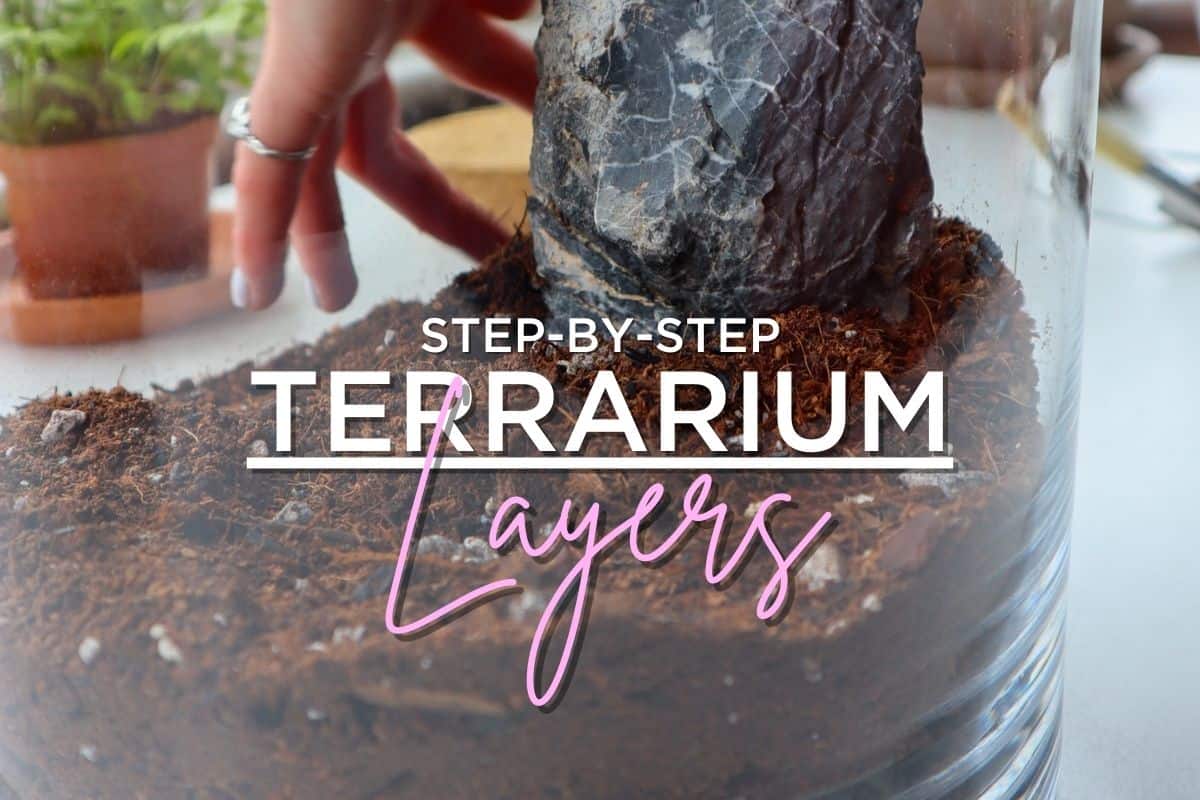
Terrarium Tribe is reader-supported. When you purchase through links on our site, we may earn an affiliate commission (at no further cost to you). 💜
The 7 Key Terrarium Layers in Order
Okay, so I’m using the term “layers” literally for the first four, but the rest are figurative.
Each step builds upon the last, so it’s helpful to think of them as layers as we build up our terrarium.
Some of these layers are essential (you’re not going to get far without a substrate, for example), but some of them are optional and/or variable. All will be explained in due course.
Without any further ado, I present to you the terrarium layers order:
1 | The Drainage Layer – There are a multitude of approaches to building a solid foundation for your terrarium, but they all begin with a simple drainage layer.
2 | The Barrier Layer – Often skipped altogether, this easy addition will keep the drainage layer functioning properly for a long time.
3 | The Activated Charcoal Layer – The trusty trick up any terrarium builder’s sleeve – activated charcoal is used for its handy filtration purposes. Learn which type to choose.
4 | The Substrate/Soil Layer – The supporting structure and growth medium for our plants. Find out how to judge how thick it needs to be and how to manipulate it for better scale and aesthetics.
5 | The Hardscape Layer – Anything that’s solid and not living really, but we’re mostly talking about dynamic-looking rocks and driftwood that add a certain natural flair.
6 | The Plant Layer – The best bit, obviously. Mostly terrestrial terrarium plants of course, but also moss highlights and epiphytic species for 3D planting.
7 | The Decorative Layer – Any final decorative elements that you’d like to add. Perhaps a little sign, human figurine or water feature. Make it your own!
Next, we’ll break down each individual section so you can choose the right options for your own terrarium project.
1 | The Drainage Layer
A strong terrarium foundation underpins the whole structure.
Much like the one beneath our home, it should be able to resist compaction, support the layers above it, and provide a space for excess water to drain into.
After all, just like the real world, our terrariums can benefit from a built-in drainage mechanism. Without that, we’d risk turning our rainforest/home into a bog – which isn’t good for plants… or humans.
A drainage layer (otherwise known as a false bottom) is the most common way to avoid this issue.
Essentially, the false bottom is a reservoir created by a layer of chunky drainage material. These can be large rocks, colored aquarium gravel, decorative pebbles, or other such non-uniform objects.
The water can drain into here from the substrate (protecting your plants from soggy soil and root rot) before later evaporating to perpetuate the water cycle.
Ideally, you’ll want something lightweight so as to not crack the glass container, so I tend to recommend something like lava rock or leca.
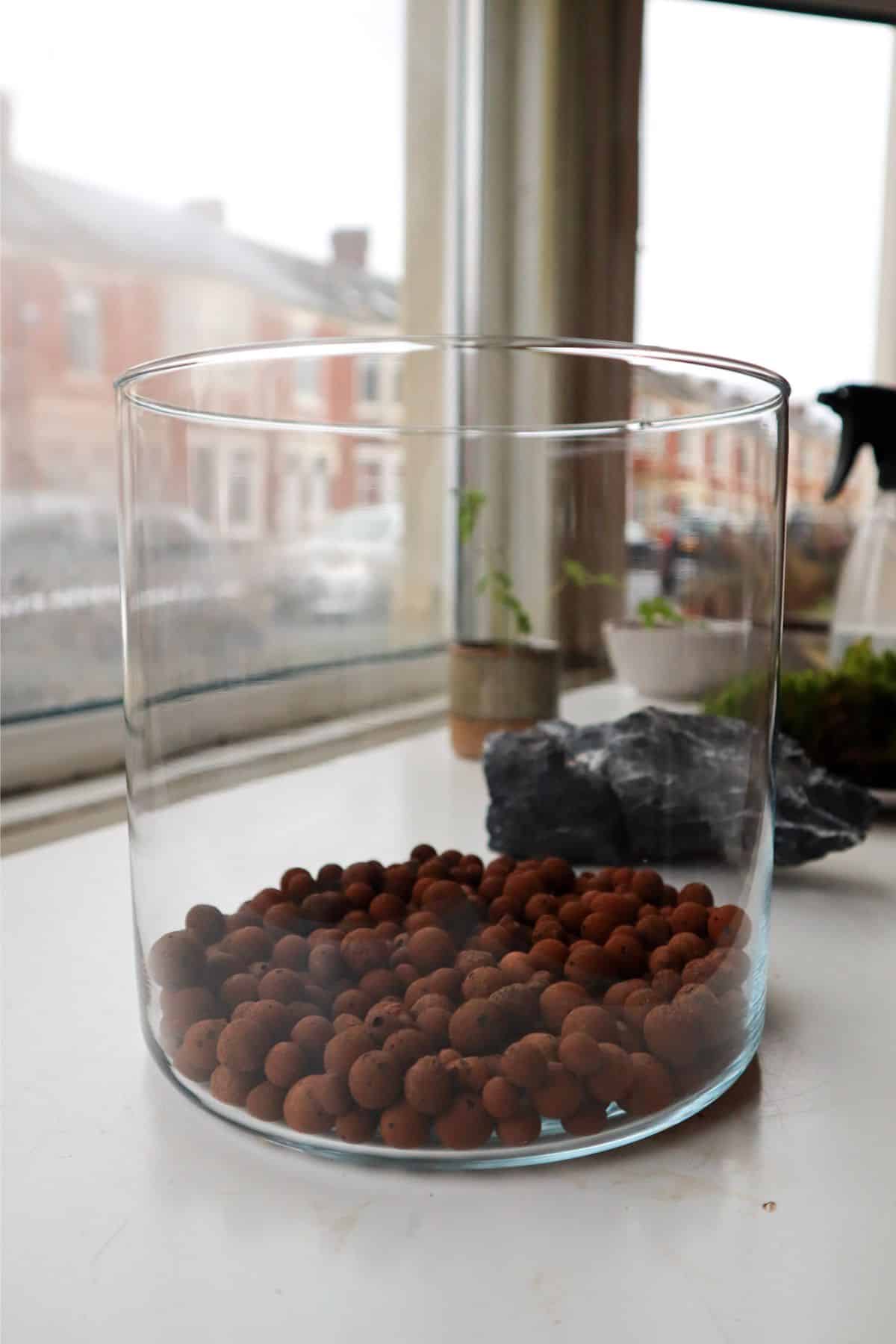
In fact, leca is a perfect choice as it’s able to provide lots of support and it can absorb a lot of water too. Helping to sequester that water and boost humidity at the same time.
Win-win.
👉 Shop leca here on our store.
2 | Barrier Layer
To work effectively as a reservoir, the drainage layer must have space for water to freely drain into.
The whole process quickly grinds to a halt if it gets clogged up with soil or debris… and that’s exactly what we’re putting on top of it.
So, it’s a good idea to use a barrier of sorts to separate the drainage layer from the substrate layer. Without one, at some point, the plants’ roots can and will grow into the drainage layer, so if you want your terrarium to go the distance, this layer is essential.
You can use:
- Something natural, like a spongy sphagnum moss layer. This brings multiple benefits, from water retention to antibacterial action, but you can need quite a thick layer to do the job (and it’s not to everyone’s taste aesthetically).
- Something artificial like a mesh. This is much thinner and less conspicuous, but just make sure it’s resistant to water, as a steel mesh is likely to rust over time.
Both can work well, but I do think the mesh is a better option.
👉 You can find terrarium substrate mesh on our store at a range of sizes to fit your project.

3 | Activated Charcoal Layer
While not strictly essential, a layer of activated charcoal is used to purify the water (though just how much it helps is difficult to quantify).
Just note you’re probably better off choosing a chunkier charcoal rather than a powder. A fine powder may flow into the drainage layer, even through a barrier mesh.
Your main choices are between activated charcoal and horticultural charcoal. Both can perform filtration, but the former will be far more effective.
We sell a coconut-based, fine-grade activated charcoal.
So it’s versatile and ecofriendly! 👇
👉 Shop activated charcoal for terrariums.
Decorative Sand Layer (Optional*)
For those looking to really accentuate the layers of a terrarium, a decorative sand layer is something to experiment with.
Honestly, by delicately layering colored sand, you can create some lovely crisp lines.
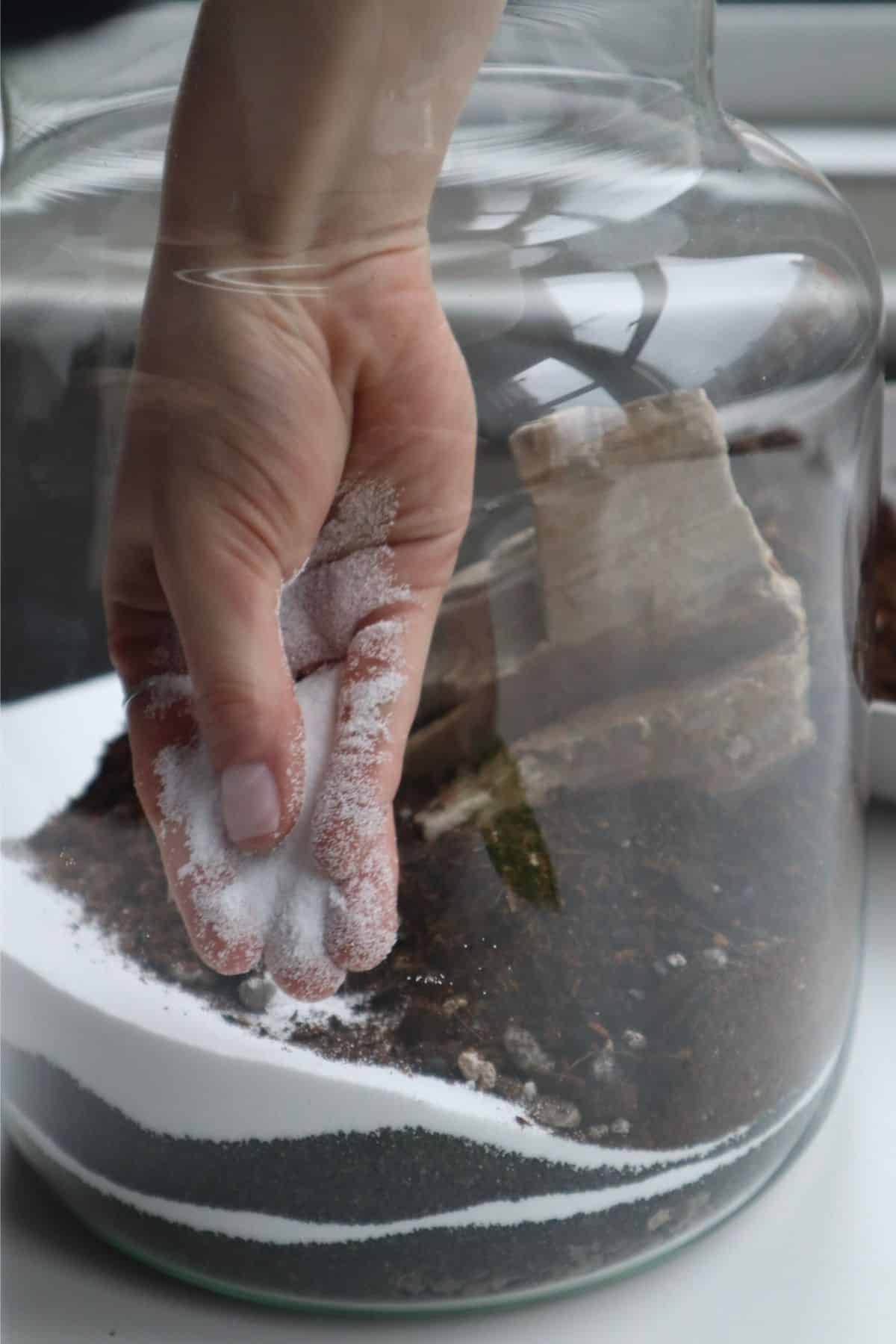
It takes a steady hand, though. See Joe’s guide to terrarium sand layers for more help with this intricate terrarium art technique.
4 | Terrarium Soil Layers
There are a whole bunch of options when it comes to terrarium soils and substrates.
The one that’s right for you will depend on your choice of plants and build. But if you’re going with tropical plants, then good drainage, water retention, and aeration are the qualities you want to shoot for.
A potting soil mix is far from ideal for tropical plants. You’ll need something light and chunky instead, and our custom terrarium mix is designed to be exactly that.

Premium Terrarium Substrate Mix
Our carefully crafted blend that balances all of your plants’ needs.
Available on the Terrarium Tribe Store.
Alternatively, the ABG mix is another tried-and-tested tropical substrate that I often use as a base.
In terms of how thick this layer needs to be, let the plants be the judge. It must be able to accommodate the biggest root ball and still have room for the roots to grow.
However, just remember, you can always slope the substrate to create areas of greater and lesser depth as needed!
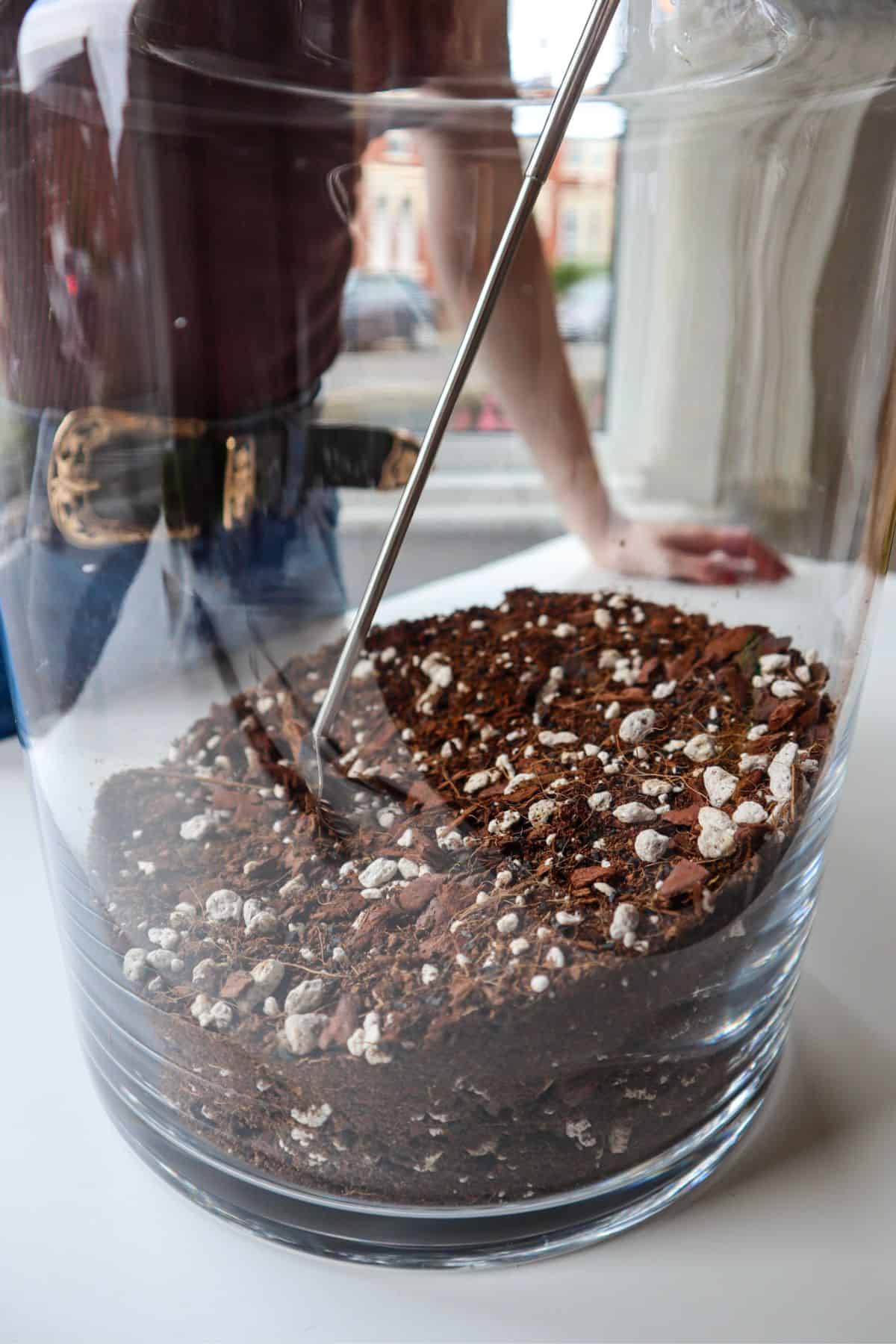
Alternatively, if you need to accommodate some larger plants (or simply don’t like the look of rocks at the bottom of your terrarium), you can forego the drainage layer altogether.
You’ll need a mix that has the right amount of drainage and support for plants – both nutritionally and physically – but it’s arguably more naturally aesthetic.
There’s the argument that once you have the watering down to a tee, you don’t really need a drainage layer. Some go so far as saying that if you already have water pooling in a drainage layer, it’s already too late…
Personally, I see a drainage system as a helpful fail-safe. I think if you’re new to terrariums, they can absolutely provide some helpful reassurances and opportunities for unique designs. Everything is an experiment!
Next, we’re onto the more dynamic parts of terrarium building.
5 | The Hardscape
In the art of terrarium building, hardscape is a term for the tough, physical elements that you might add.
Decorative rocks (e.g., dragon stone) and driftwood branches (e.g., manzanita wood) are the most common kind, but the likes of crystals and pebbles would fall into this category too.
Hardscape isn’t used in every build, but it can elevate a terrarium in a variety of ways:
- Helps build a solid base – embedding large physical objects in the substrate can really help to stabilize it, especially if it’s uneven (if you’re making a higher background, for example).
- Create a sense of depth – you can physically manipulate the terrarium landscape, using scale and focal points to create a sense of depth. Adding a large object at the front and smaller ones at the back is one way to do this.
- 3D planting opportunities – rocks and branches are able to comfortably grow a variety of plant species on them. This allows for much more creative expression in how you plant your terrariums.
- Pure decoration – if nothing else, hardscape is beautiful unto itself, and can often be a prime feature on its own.
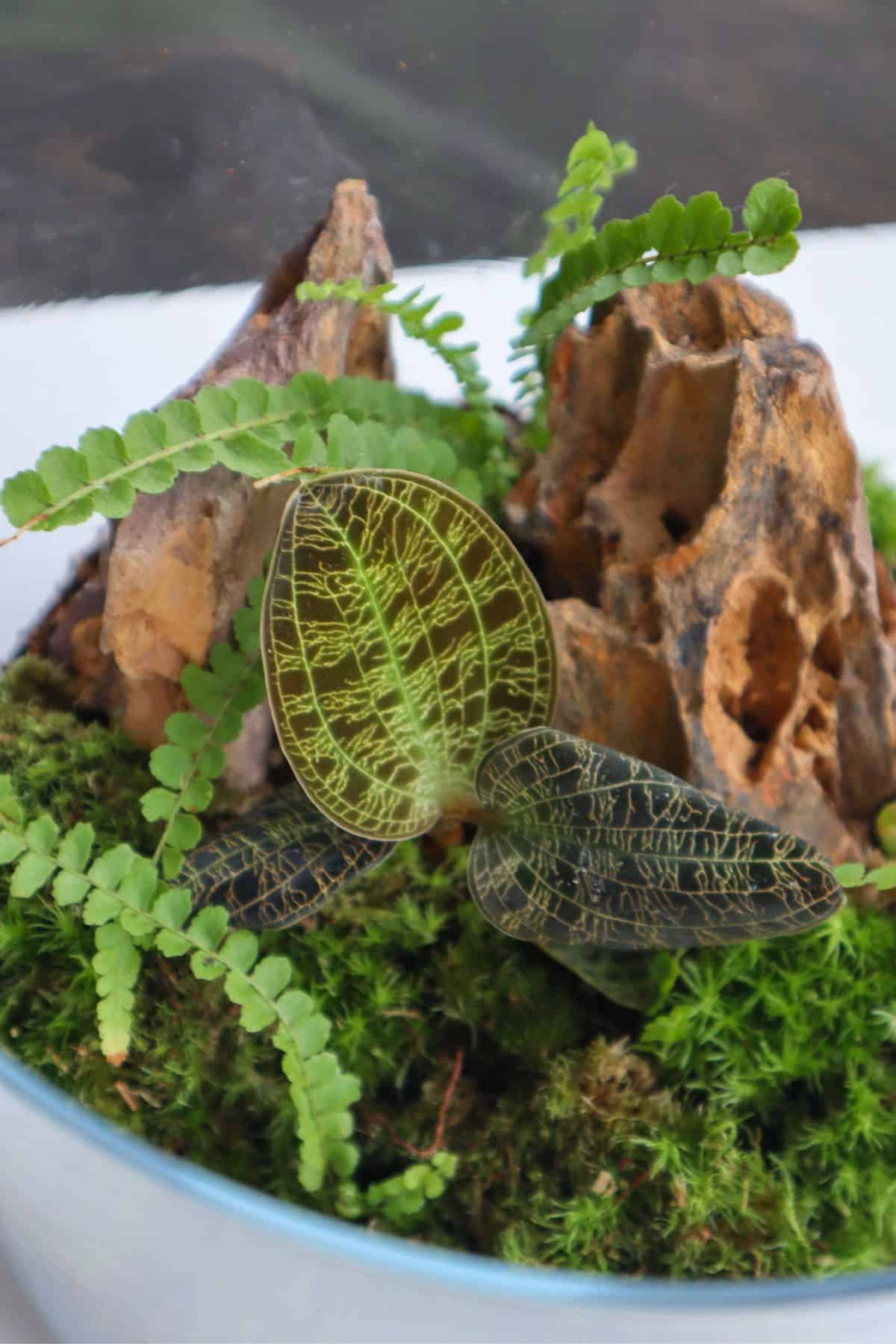
Hardscape elements should generally be added straight after the substrate as they’re often the main feature, but also because their addition can alter the landscape so much.
There’s no point spending hours creating a beautiful green landscape only to have it warped by a large stone.
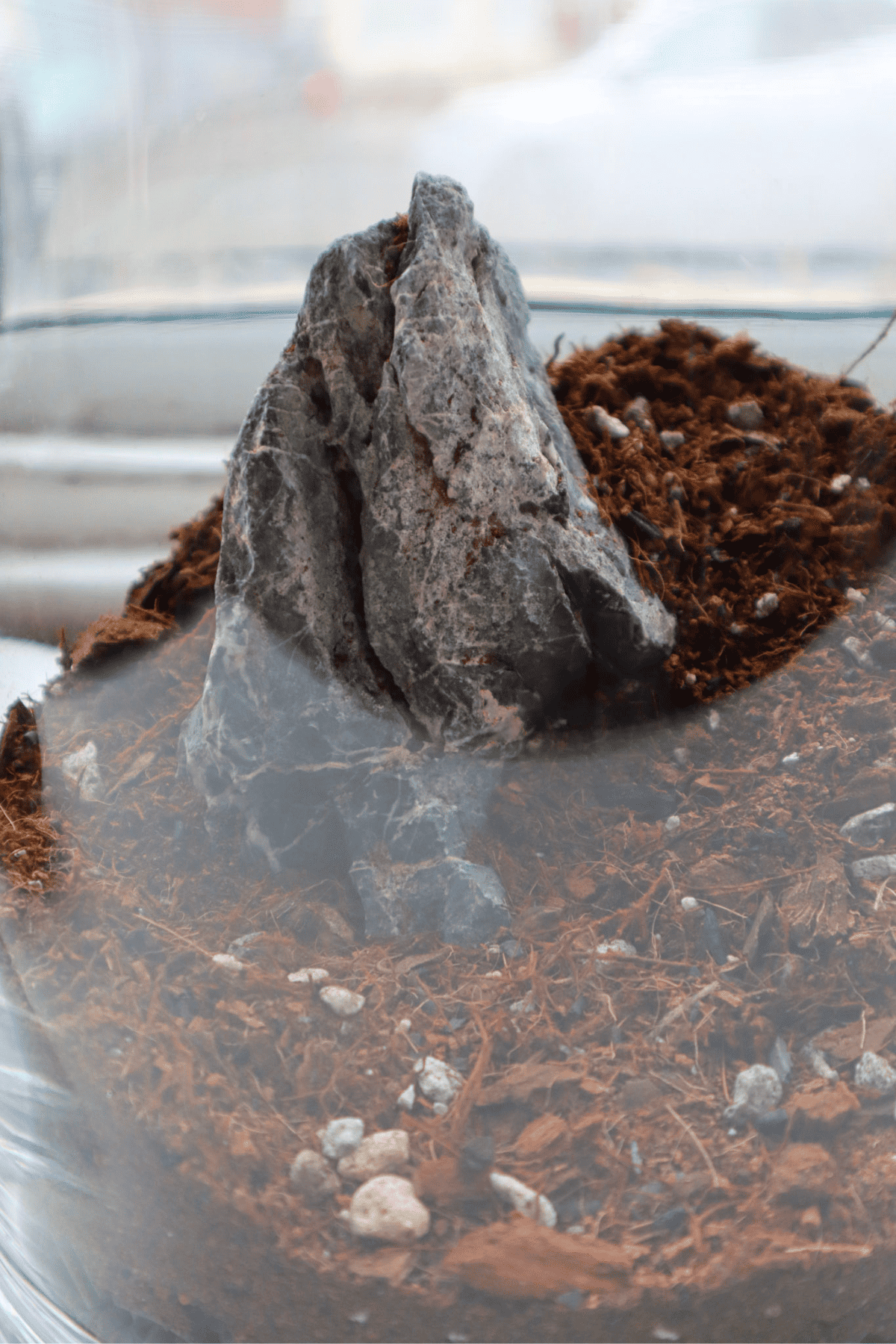
6 | The Plants
You’ll generally want to start planting with your biggest and most important sealed terrarium plants.
Not just because bigger plants will be harder to place when your terrarium is full but also because your feature plants should take priority in the best viewing spots.
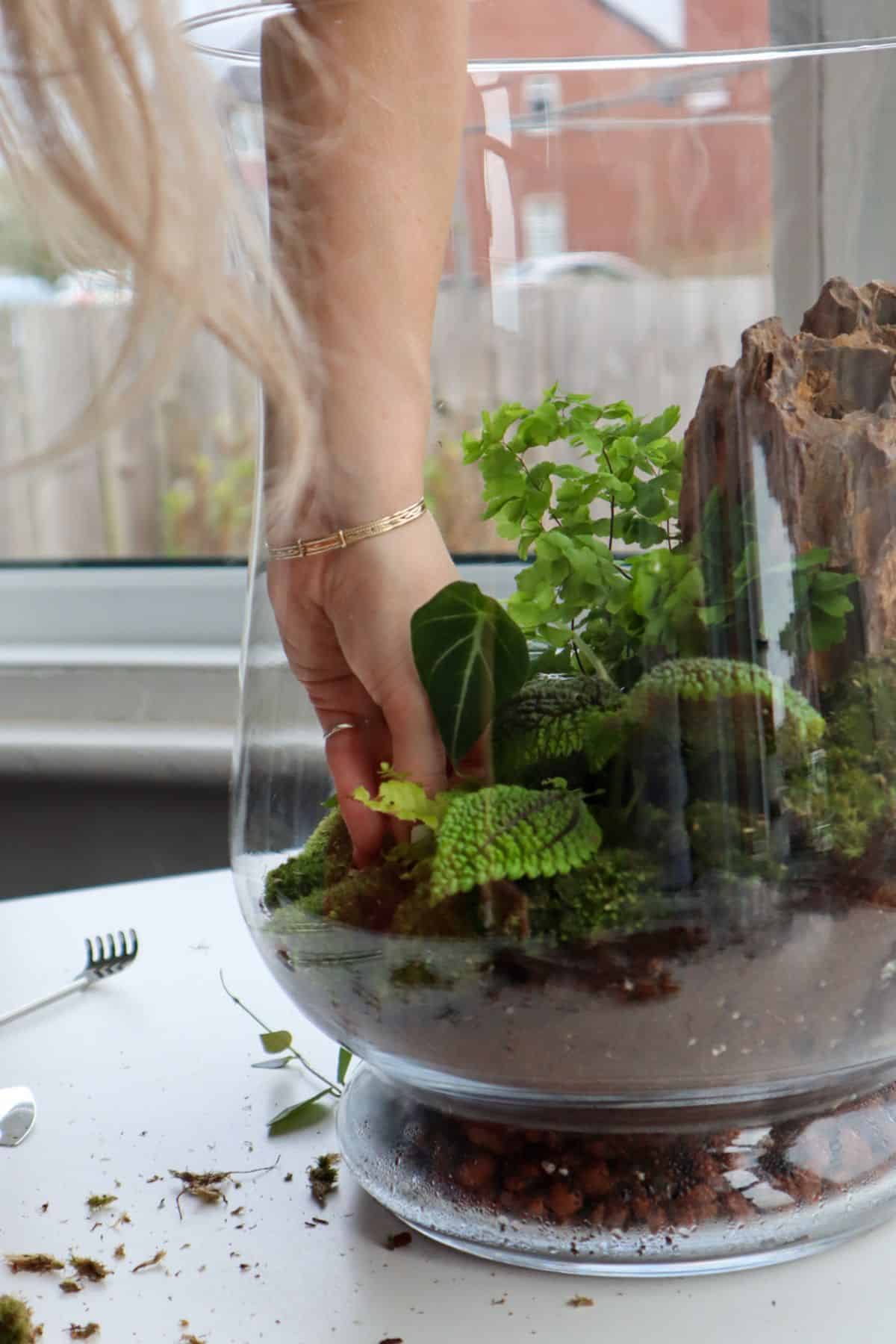
Mosses typically come last because they’re primarily there to cover exposed earth for a more natural look, and you don’t know what’s left exposed till the end. Right?
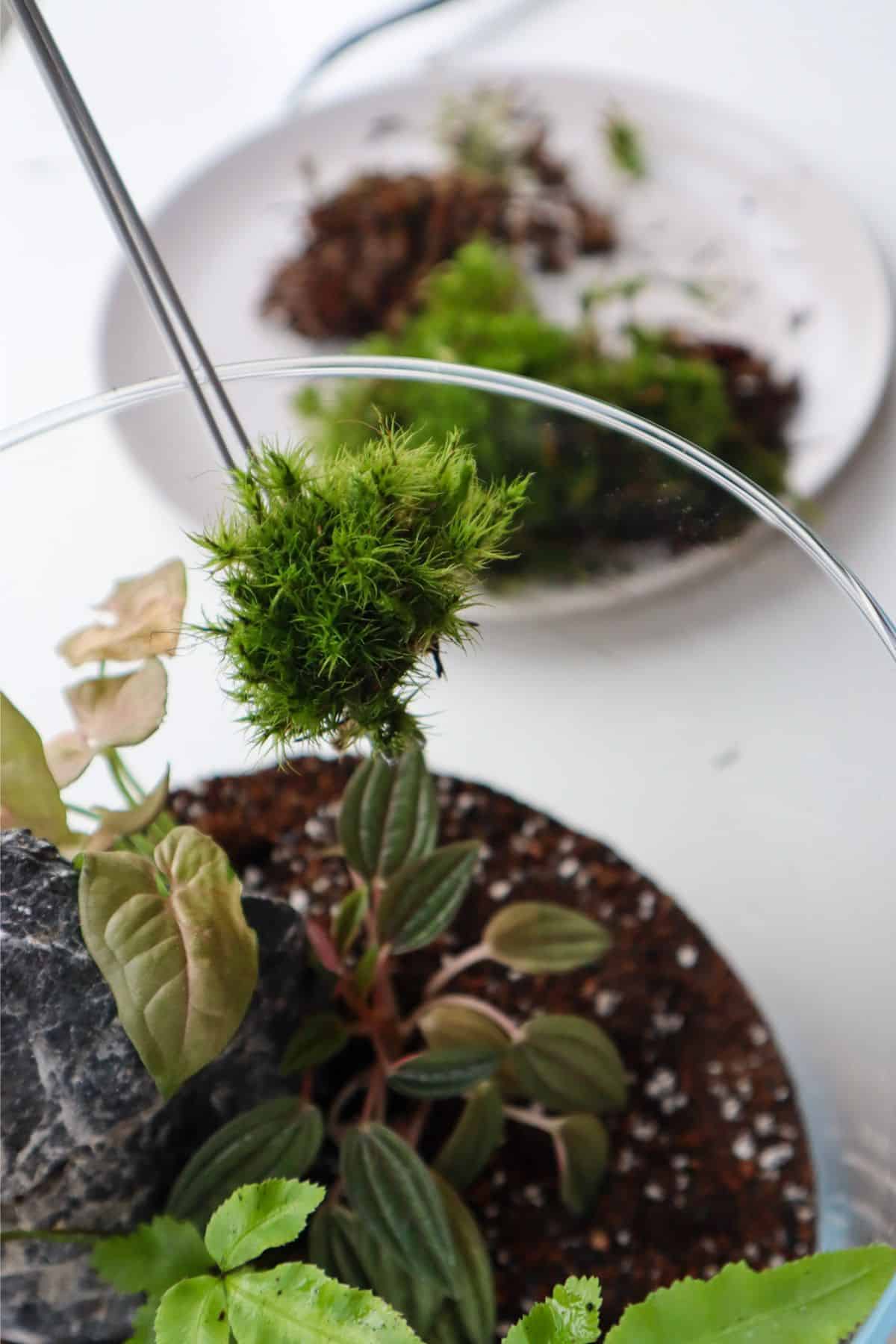
Generally, moss is great for pulling together the final look. Different mosses are better for different things, and often a mix of species is best to achieve a diverse, natural look.
👉 Shop our live terrarium moss collection.
If you have opted for some wonderful driftwood additions, now is the time to attach any epiphytic plants you might have.
Semi-aquatic ferns and miniature vines are great options for a tropical closed terrarium (though air plants need some occasional airflow).
7 | Final Decorations
It’s entirely up to you how you decorate your terrarium and what you use to do it.
Whether you prefer to preserve the pristine plant environment or you want to construct an entire Jurassic Park set with dinosaur figurines (a solid choice), it’s your decision.
Common ways to add decorative layers are by covering the soil with decorative stones and sea shells, placing figurines amongst the plants, or even adding waterfall features.
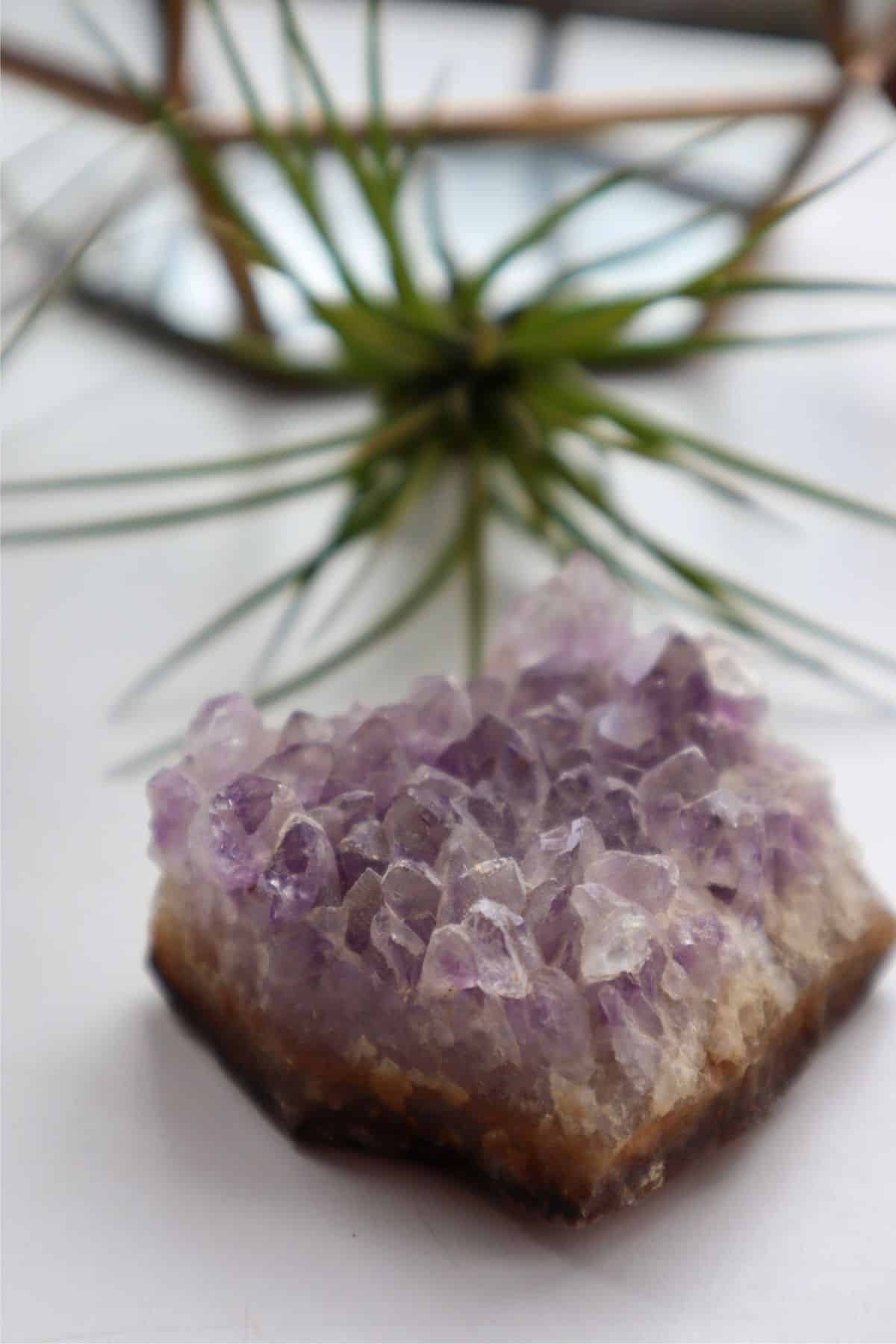
Open Terrarium Layers vs. Closed Terrarium Layers
As they’re best suited for arid succulent plants and cacti, an open terrarium has quite a few differences compared to its closed tropical counterpart.
They don’t need to hold moisture, so you won’t need a lid or a particularly water-retentive substrate.
However, it will need excellent drainage for optimum conditions.
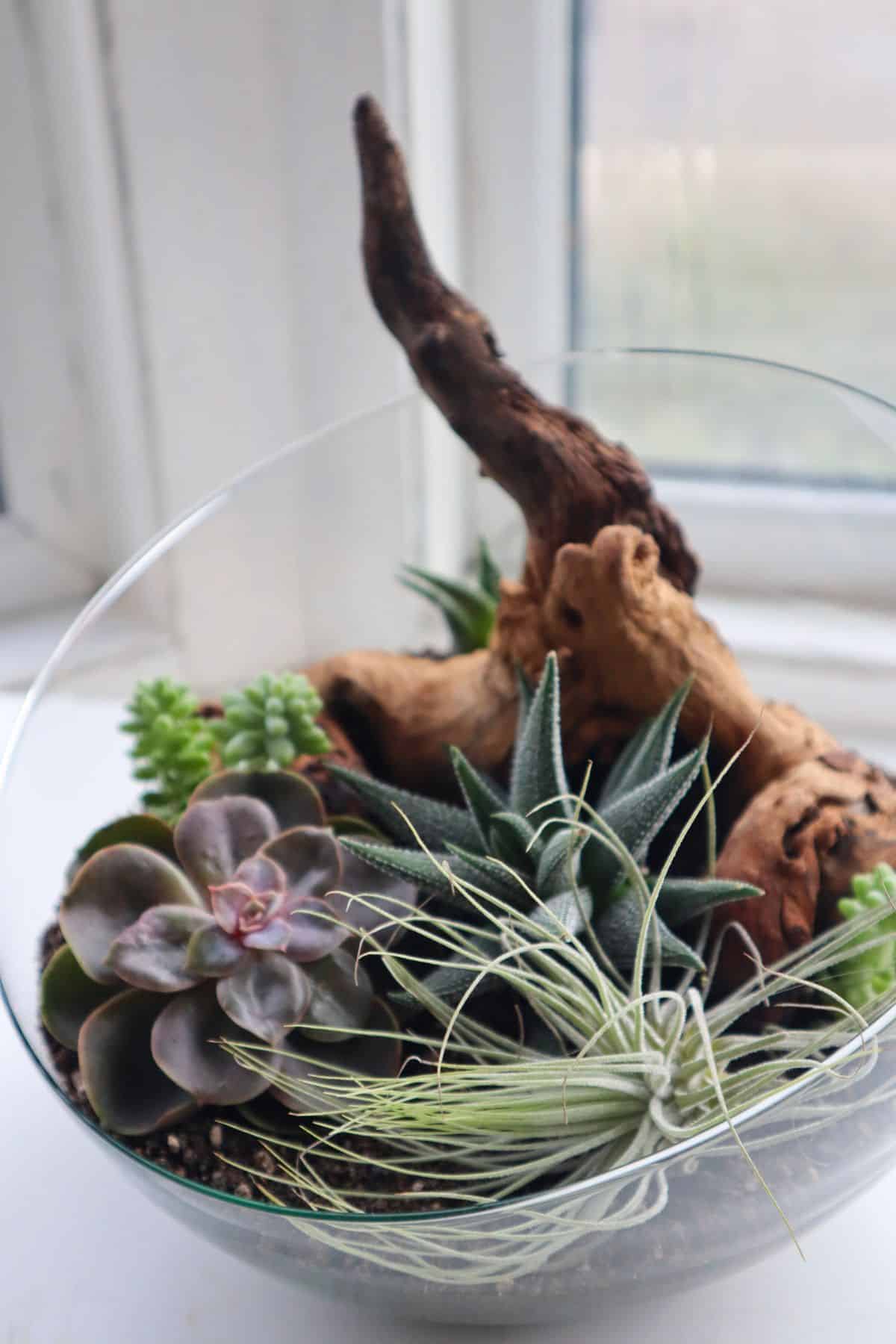
Just remember, it takes a different approach to water succulents. You’ll be watering succulent terrariums much less frequently, and you’ll need to give it plenty of time to dry out.
An issue helped by the fact that open terrariums tend to be placed in full sun – rather than the standard bright indirect light for tropical terrariums – meaning they’ll dry out much faster.
So, at least you have a lot more wiggle room with watering.
Now It’s Your Turn
Hopefully, you’ve got a good idea of how to layer a terrarium now and what basic terrarium supplies you may need.
Which foundation approach do you tend to favor? Are you a fan of the false bottom method?
Let me know in the comments.

Just made my first Terrarium in a Demijohn. Waiting to see the outcome. Not yet decorated and sealed.
Congrats, you must like a challenge if you’re trying a demijohn first!
Hi thank you for the helpful advice.
Love to see pics… and know how much medium and such you used. What plants did you select… I’ve just acquired two demijohns… and looking to turn one into a terrarium…
Enjoy the content
I’ve been making terrariums for my wife’s business for about 2 years now and it’s been a learning curve! I personally prefer to layer using a gravel drainage bottom layer, a good layer of activated charcoal, then substrate, I also build up layers of sand and fine gravel as I build up, makes the terrarium look like it’s been perfectly dug out of the ground with geological looking lines in the substrate. I have also just introduced tropical isopods and springtails for the ultimate self sustainable biosphere. Its so rewarding mentally and of course its awesome when you get great feedback from customers. Thoroughly enjoyed your article!! 👍
Absolutely, there’s definitely an art to layering up that I haven’t quite mastered yet! It’s great to hear you’re finding such success with terrariums Daniel. 😀
How thick should the layer of gravel be?
Hi Madeline, there’s no ideal number per se – it’s going to depend on your container and design – but I usually aim for about 1-2 inches.
Thanks for all your helpful information!
Hi! Should the sphagnum moss be alive or dried?
Dried is the default choice for inner layers. Live moss will likely still work, but it’ll probably, you know, grow.
Hi! Thank you for posting this article, it’s very informative. I was wondering if you can plant ferns in a closed terrarium, and if so, do you have any paticular species reccomendations? Thank you!
Absolutely – ferns are great choices. Check out our minature ferns and terrarium ferns guides.